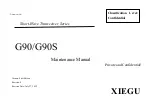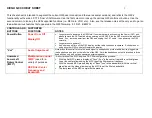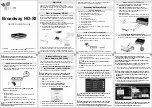
MFT-20 DSB Transceiver Kit
Page 23
Adjustment of the RX pass band, L1, L2 and L3
For this adjustment you will need an “alignment” tool suitable for this type of coils; if you use a
screwdriver, you risk of breaking the core of the coil.
With an 14MHz band antenna connected to the transceiver, sequentially adjust L1, L2 and L3 until
obtaining the maximum level of noise in the speaker. Now, try to tune in a stable signal within the band
and readjust L1, L2 y L3 until you hear it at the highest possible level.
If you have access to an RF generator, begin injecting a signal of about 5uV within the frequency
coverage of receiver and tune it in. Reduce the level of the RF generator to the minimum that is still
audible with a loudspeaker or headphones, and sequentially adjust L1, L2 and L3 until obtaining the
maximum reception level.
REMEMBER: All transmission tests should be done with a 50 ohm load
connected to the transmitter output.
Adjustment of the TX transformer L6
Connect a power meter with a 50 ohm load to the antenna jack.
Adjust the mic gain P3 to maximum. Push to talk, (put the transceiver in transmit mode, PTT to “GND”).
Speak loudly or whistle in front of the microphone and adjust L6 to achieve maximum output power.
Adjustment of DSB carrier suppression P4
Connect a power meter with a 50 ohm load to the antenna jack.
Adjust the mic gain to minimum (completely clockwise). Adjust P4 (carrier suppression) to mid-position.
If you have access to an oscilloscope you can monitor the power output to make this adjustment.
If you do not have access to instrumentation, you can tune an amateur radio receiver to the frequency of
the MFT transceiver.
Push to talk, (put the transceiver in transmit mode, PTT to “GND”) and adjust P4 until the minimum
residual carrier at the transmitter output is obtained. (or minimum signal is heard in the receiver).
If you do not have oscilloscope or receiver, then set P4 to mid-position.
Adjustment of mic gain P3
This adjustment will be a little ambiguous, since it depends a lot on the operator's type of voice and way
of speaking. Use the “cut and try” method. To get the maximum power you can set P3 almost to the
maximum. If you want to work with very low power (QRPp) you can set P3 to a low level.
It is recommended that you request a fellow operator to critique your modulation.
Normally the position in 75% of the route is correct
USEFUL NOTES
Using a mechanical reduction dial or a 10-turn potentiometer
Although 50-60KHz can be tuned perfectly with a one-turn potentiometer and a large diameter control
knob. You have the possibility to replace the potentiometer by a 10-turn or add a mechanical reducer dial
(see components at
www.ea3gcy.com
)









































